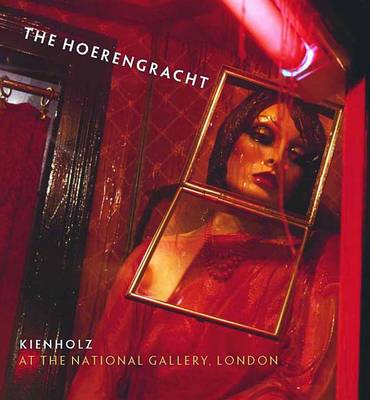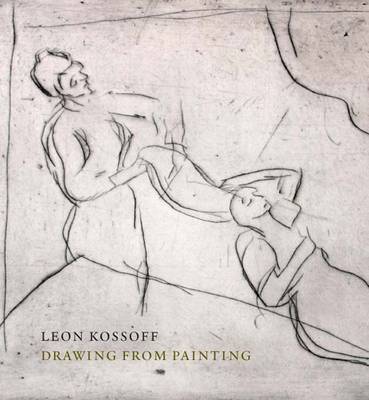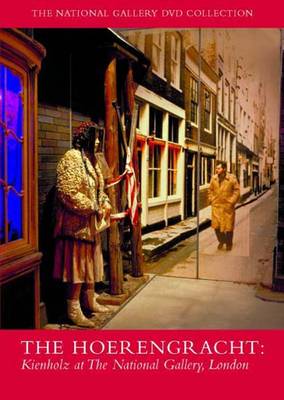National Gallery London
6 total works
The Hoerengracht (1983--88) is an installation artwork by Ed Kienholz (American, 1927--1994) and his wife, Nancy Reddin Kienholz. This tableau----a surprising site in the National Gallery----is a walk-through evocation of Amsterdam's red-light district, with glowing windows and claustrophobic streets. With its statements on morality, vanitas, and composition of secret spaces and receding views, The Hoerengracht resonates powerfully with paintings by Dutch masters of the 17th century. The work was the last major piece made by the Kienholzes before Ed died and remains a major reference point for contemporary artists including Mike Kelley, Paul McCarthy, Mike Nelson, and Damien Hirst. This striking exhibition catalogue positions The Hoerengracht and Kienholz in a new perspective.
Known for his expressive portraits and London landscapes, draftsman, printmaker, and painter Leon Kossoff (b. 1926) is one of the most significant British artists of the past fifty years. A member of the School of London----a group of loosely representational painters including Frank Auerbach, Francis Bacon, and Lucian Freud----Kossoff views drawing as fundamental to the artistic process and has turned to art history for inspiration throughout his career. This handsome book features a selection of drawings and prints made over thirty years after paintings by such artists as Poussin, Rubens, Velazquez, Degas, Cezanne, and Goya. Absorbing essays discuss how Kossoff has used this body of drawings to inform his original paintings and analyze how the particular influence of Old Masters has been incorporated into his work.
Tom Hunter has become internationally renowned for creating engaging, distinctive and often provocative photographic reworkings of paintings from the past. In 1998 he won the Kobal Photographic Portrait Award at the National Portrait Gallery, London, for Woman Reading a Possession Order, a beautifully crafted photograph based on a composition by the Dutch Master, Johannes Vermcer (1632 - 1675). This book presents some of the striking images that have established Hunter's reputation, together with new work created especially for the exhibition Tom Hunter: Living in Hell and Other Stories at the National Gallery, London (7 December - 12 March 2006). Many of these images draw on the lives of the ordinary residents of Hackney, East London, as captured in the headlines of Hunter's local newspaper, the Hackney Gazette. These startling, sometimes tragic, stories are retold in carefully staged photographs, whose compositions are frequently derived from paintings in the National Gallery's collection. An essay by Tracy Chevalier examines Hunter's story-telling, while Colin Wiggins discusses the relationship between Hunter's work and Old Master paintings in the National Gallery and elsewhere.
"The Hoerengracht" is a strikingly controversial installation piece by Ed Kienholz and Nancy Reddin Kienholz. It is a walk-through evocation of Amsterdam's red light district, complete with alleys and brothels. Within the traditional, elegant walls of the National Gallery, such a gritty, unglamorous tableau may seem an incongruous sight, but this film shows surprising parallels with the Gallery's collection of Dutch paintings of the seventeenth century. Footage includes the Kienholz studio in Idaho, where The Hoerengracht is unpacked in preparation for the National Gallery exhibition. Nancy also returns to Amsterdam and discusses the changes she sees in the city's notorious red light district and how art has been a part of this. The exhibition Kienholz: The Hoerengracht opens at the National Gallery, London, on 18 November 2009 and runs until 21 February 2010. The exhibition then travels to the Amsterdam Historisch Museum (Museum Willet-Holthuysen) in Spring 2010. Parents and teachers should be aware that this film discusses adult themes.
Kitaj in the Aura of Cezanne and Other Masters
by Anthony Rudolf and Colin Wiggins
Published 2 November 2001
For almost four decades, R.B. Kitaj played an integral role in British art. His enigmatic and highly personal paintings engage with contemporary culture, his Jewish identity and horror of the Holocaust. Shortly after his controversial retrospective at the Tate Gallery, London in 1994, he moved back to his native United States and now lives and works in Los Angeles. His great hero is Cezanne: "He is my greatest painter of all and the three last Bathers are my favourite art of all". He recently embarked upon a series of six major new pictures inspired by Cezanne's Bathers for an exhibition at the National Gallery, London. In this fully illustrated book, Kitaj's new paintings are reproduced for the first time, together with a series of beautiful black chalk drawings, directly inspired by Cezanne. The new paintings are discussed in the context of earlier works by Kitaj, which reveal his constant preoccupation with the Old Masters. The book includes a short essay about Kitaj's work, plus a new and previously unpublished interview with the artist.
For 50 years Bridget Riley has been regarded as Britain's most important abstract painter, renowned for her large abstract paintings, with their complex, repetitive geometric shapes and undulating linear patterns. Given the graphic nature of these works, it is fascinating to discover that Riley sees her decidedly modern paintings as following in an Old Master pictorial tradition. This affinity stems from her lifelong passion for paintings in the National Gallery, London, with which she has a long association: first as a young student and copyist and later as a Trustee. In 1989 Riley was honoured with an exhibition, 'The Artist's Eye'. "Bridget Riley: Arcadia" will mark the artist's long engagement with the National Gallery. Colin Wiggins explains with great clarity and enthusiasm how the fluid lines of Renaissance and Baroque paintings, together with their palette of ochres, salmon, greens and light blues translate into the abstracted shapes that appear in Riley's paintings. Marla Prather looks at how the techniques and methods of modern masters such as Cezanne, Seurat and Matisse also act as an important influence in her paintings.
This catalogue and DVD accompany the National Gallery exhibition Bridget Riley: Arcadia which opens on 16 November 2010.
This catalogue and DVD accompany the National Gallery exhibition Bridget Riley: Arcadia which opens on 16 November 2010.





